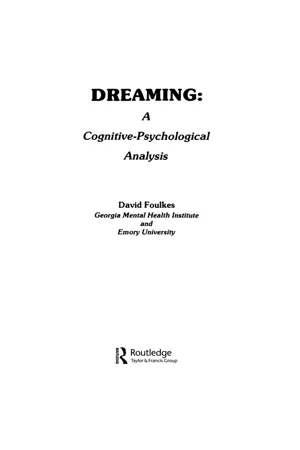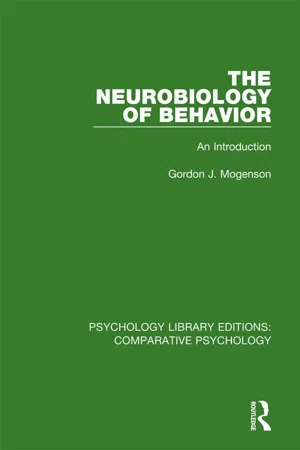Psychology
Stages of Sleep
The stages of sleep are divided into non-rapid eye movement (NREM) and rapid eye movement (REM) sleep. NREM sleep consists of four stages, with each stage representing a different level of depth. Stage 1 is light sleep, while stage 4 is the deepest sleep. REM sleep is characterized by rapid eye movements, increased brain activity, and vivid dreams.
Written by Perlego with AI-assistance
Related key terms
5 Key excerpts on "Stages of Sleep"
- Nancy Fenton, Jessica Flitter(Authors)
- 2015(Publication Date)
- Research & Education Association(Publisher)
delta waves that have the lowest frequency and high amplitude (height). During the third and fourth stages, heart rate, breathing, and brain waves slow down considerably and it is difficult to wake a person. Stage 4 sleep is the stage when sleepwalking and sleep terrors frequently occur.After reaching stage 4 sleep, the sleep cycle reverses through stage 2, but never returns to stage 1, and instead enters the REM stage. For example, a typical sleep cycle pattern consists of stages 1, 2, 3, 4, 3, 2, REM. REM sleep is characterized by low amplitude (height) and high frequency sawtooth-like waves that are very similar to beta waves predominant when an individual is awake. REM is named for the rapid eye movements (REM) happening under closed eyelids that often occur during this stage. Based on sleep research, most dreams (including nightmares) occur during the REM sleep stage. About 80 percent of people who were awakened during REM remembered their dreams, as opposed to less than 10 percent of subjects who were awakened during non-rapid eye movement (NREM) . Dreams can happen in other Stages of Sleep, but they are typically less vivid and unusual, and subjects report that they feel more like normal thought. Physiological changes during REM sleep involve increased heart rate, breathing, and blood pressure. Other physiological changes unique to REM include the inability to move voluntary muscles and evidence of sexual arousal. REM sleep is also called paradoxical sleep because it represents a contradiction. The paradox is that, although the body is asleep, brain-wave activity and bodily changes that are commonly associated with arousal are being demonstrated. Furthermore, despite the internal state of the individual being very active, the individual cannot physically move.STUDY TIPBe able to provide evidence, such as REM rebound, for the significance of REM sleep.Psychologists have deprived subjects of REM sleep to study the importance of this unique stage. Using an EEG, psychologists wake participants up as they enter REM sleep. When the REM-deprived subjects are allowed to sleep again, individuals enter into REM sleep very soon after they fall asleep and experience more REM time overall in what is called REM rebound- eBook - ePub
- Kat Duff(Author)
- 2014(Publication Date)
- Atria Books/Beyond Words(Publisher)
Sleep is characterized by two essential features—a reduced response to outer stimulation and the ability to wake up quickly—which distinguish it from other similar states, such as coma, anesthesia, hypnosis, hibernation, or death. When the sleep switch flips on, our brains shut down (most) sensory input and reduce motor output, in effect disabling our capacity to engage with the world. The supply of brain chemicals that facilitate short-term memory and self-reflection is cut off, making it difficult to observe and remember what happens when we sleep. When we have slept long enough, the sleep switch flips off, reversing these conditions, and we open our eyes.However, sleep is not a single, unvarying state of consciousness. It has its own fluctuations, what could be called an ongoing dialogue, between deeper and lighter phases with chemical signatures and brain wave patterns that are as different from each other as they are from waking. While other stages have been identified based on EEG patterns, they are essentially preludes and postludes to these two basic types of sleep: rapid eye movement (REM) sleep and slow-wave (SW) sleep. These two kinds of sleep alternate some five to six times a night, every ninety minutes on average, serving different, though interconnected, roles.REM Sleep
REM, the busiest stage of sleep, was named by Nathaniel Kleitman because our eyes dart back and forth beneath closed lids and our brain waves speed up into highly differentiated flurries while our bodies lie still, temporarily paralyzed. One sleep researcher described it this way: “The brain is on fire . . . but the body is a cold fish.”1 REM is so active, it literally heats up the brain, requiring further Stages of Sleep to cool down. The sympathetic nervous system triggers bouts of rapid heartbeats, heavy or arrested breathing, spikes in blood pressure, and faster metabolism. Dreams are vivid, abundant, and easier to remember during this stage. The capacity for REM sleep is very old in evolutionary terms; one prominent sleep researcher, J. Allan Hobson, has suggested that it preceded and fostered the development of waking consciousness.2While we tend to think of ourselves as unconscious when we sleep, most contemporary neuroscientists would agree with ancient philosophers that we are conscious when we dream. After all, we experience dream events as real in the moment. Neuroscientist Rodolfo Llinás went so far as to state that dreaming “is consciousness itself in the absence of input from the senses.”3 Neurologist Oliver Sacks inverted the equation to make the same point when he stated, “Waking consciousness is dreaming—but dreaming constrained by external reality.”4 - eBook - ePub
Sleeping, Dreaming, and Dying
An Exploration of Consciousness
- Dalai Lama, B. Alan Wallace, Thupten Jinpa, Francisco J Varela(Authors)
- 2002(Publication Date)
- Wisdom Publications(Publisher)
“For a more complete picture of these various states of human consciousness, let us compare non-REM and REM sleep in contrast to the awake state (fig. 2.5). By examining characteristics such as cerebral activity, heart rate, blood pressure, brain blood flow, and respiration, you can see that these two types of sleep are radically different configurations of the entire body. Cerebral activity is a measurement of the global amount of brain electrical activity. In non-REM sleep, the brain becomes more silent. Interestingly, in REM sleep it’s more active than in wakefulness. This goes completely against the old intuition that sleep is passive. Relative to wakefulness, the heartbeat in non-REM sleep is a little slowed down, and unchanged during REM. Brain blood flow is the total amount of circulation of blood in the brain, which is a measurement of how much oxygen and nutrients are needed. This clearly increases in REM sleep, again an indication that this is a very active process. Finally, respiration in non-REM sleep slows down a little bit, while in REM sleep it’s very variable. In summary, there is a very clear and distinct pattern here. Within non-REM sleep there are stages that progress in a continuum, but there is a radical shift from non-REM to REM sleep.”Dreaming and REM
“Do you mean that even during the non-REM stage the person can be dreaming?” His Holiness asked.“Why is the REM sleep state so important? The brain patterns of REM sleep correspond to the dream state. When you wake people up from REM sleep, more than eighty percent say that they were dreaming, and they can tell you what they were dreaming about. If you wake them up from stage four, less than half do.”“Is there only a tenuous relationship between the REM and the dream state?” he insisted.I was expecting that question. “Yes. It depends on how you evaluate the subjective report, but it is generally accepted that about half of the people who are woken up from non-REM sleep report dreaming or mental activity. Many say they were thinking rather than dreaming. They report some kind of experience or mental activity, but it doesn’t usually have the same full-fledged story quality as a dream.”I could try to qualify the answer in a fuzzy way. “It depends on how you set up your criteria. From stage four people may say, ‘I was thinking about something’ or ‘I was considering something’ but from non-REM sleep, people very rarely report a complete vivid story such as ‘I was flying like an eagle and I saw my home.’ In non-REM sleep, it’s more like mental content than like a movie. Even in going from awake to sleep, one sometimes has very brief flashes of imagery, called hypnagogic dreaming. Such sudden bursts of imagination, whether visual or auditory, also occur in people left in darkness. So it’s not fair to say that dreaming occurs only in REM sleep because other kinds of dreamlike experiences occur in all of the other stages. But it is clearly true that vivid, visual, storylike dreams occur classically in REM sleep.“We spend about twenty to twenty-five percent of a complete circadian cycle in REM sleep. From the neuroscientific point of view, therefore, we dream every night, although we often are not dreaming. The classical sequence of sleep patterns usually happens a second time during the day. This is called the biphasic sleep cycle. At nine A.M., after a good night’s sleep, a normal young adult takes about fifteen minutes to go back to sleep. But everybody knows that at two o’clock in the afternoon, at siesta time, it’s easy to fall asleep. Also, the time that it takes to fall asleep is typically shorter by about five minutes in an older person.” - eBook - ePub
Dreaming
A Cognitive-psychological Analysis
- David Foulkes(Author)
- 2014(Publication Date)
- Routledge(Publisher)
Dream time seems to approximate real time—or at least waking thought or imagination time. Thus, dreams do not happen in a “flash.” On all of this evidence, we regularly spend at least 11/2 hours during each night’s sleep producing reasonably vivid, imaginal, story-like dreams, the great majority of which we regularly seem to forget. These naturally “forgettable” dreams can be remembered only if, as in a sleep laboratory, we’re awakened while having them. The content of these dreams generally portrays situations and sequences of events which are not wholly out of line with those we might expect to experience in our waking lives. 3 One major hope of the early dream psychophysiologists has not been realized. “REM sleep” is a relatively gross and long-term characterization of patterns of physiological activity, which can be strikingly different from one moment to the next. Most significantly, there are moments of REM sleep in which eye movements actually occur; they often are preceded by distinctive (“sawtooth”) wave forms in electroencephalogram tracings of the spontaneous electrical activity of the cerebral cortex (as recorded by small metal-disc electrodes placed on the intact surface of the scalp). But there are also stretches—sometimes long ones (lasting a minute or more)—of REM sleep when there are, in fact, no eye movements occurring. Because the phasic or episodic activation reflected in eye movements also tends to coincide with other forms of such activation— increased variability in breathing, for instance—REMs can be interpreted as signs of a more generalized activation that periodically intrudes upon the background conditions of REM sleep. An early goal of dream psychophysiologists was to be able to show that physiological changes occurring within REM sleep were predictably related to particular kinds of changes in the accompanying dream experience - eBook - ePub
The Neurobiology of Behavior
An Introduction
- Gordon J. Mogenson(Author)
- 2018(Publication Date)
- Routledge(Publisher)
7Sleep and Waking
Like most humans, you spend about one-third of your life asleep. Some animals, such as the cat, sleep 75–80% of the time, and certain animals such as the bear, sleep most of the time—for weeks or months during a period of hibernation. Sleep alternates with waking in a regular manner, and sleep-waking is one of the most important and prominent biological rhythms. Sleep has biological significance in the sense that we neither feel well nor perform well when lacking sleep and also in the sense that it competes with ingestive, agressive, and other behaviors. Although many behaviors are absent or occur only infrequently during sleep, sleep is not the absence of behavior; rather, as suggested by several authors in this field, sleep is a distinctive kind of behavior. Considered from the ethological point of view, for example, sleep is the final consummatory phase of a complex instinctive behavioral sequence (Moruzzi, 1969). The drowsiness or appetitive phase that precedes sleep frequently includes instinctive or species-specific patterns of behavior (e.g., returning to the home territory; building a nest or shelter). Moruzzi (1969) points out that sleep may occur in a specific territory (“the area of maximum security where the young are born and cared for”), and in some species “a typical social pattern is closely associated with sleep [p. 182].”Our main interest in this chapter is with the neural substrates of sleep and waking, but we begin, as in the other chapters, by first considering the characteristics of sleep and the factors that initiate and influence sleep. There has been a great deal of activity in the field of sleep research in recent years that has led to important empirical findings and to changes in our views about the neural mechanisms. One of the major developments discussed in later sections is a change from the view that sleep is a passive process—the absence of waking—to the view that sleep is an active process; in other words, there is a neural mechanism in the brain that produces sleep.
Learn about this page
Index pages curate the most relevant extracts from our library of academic textbooks. They’ve been created using an in-house natural language model (NLM), each adding context and meaning to key research topics.




